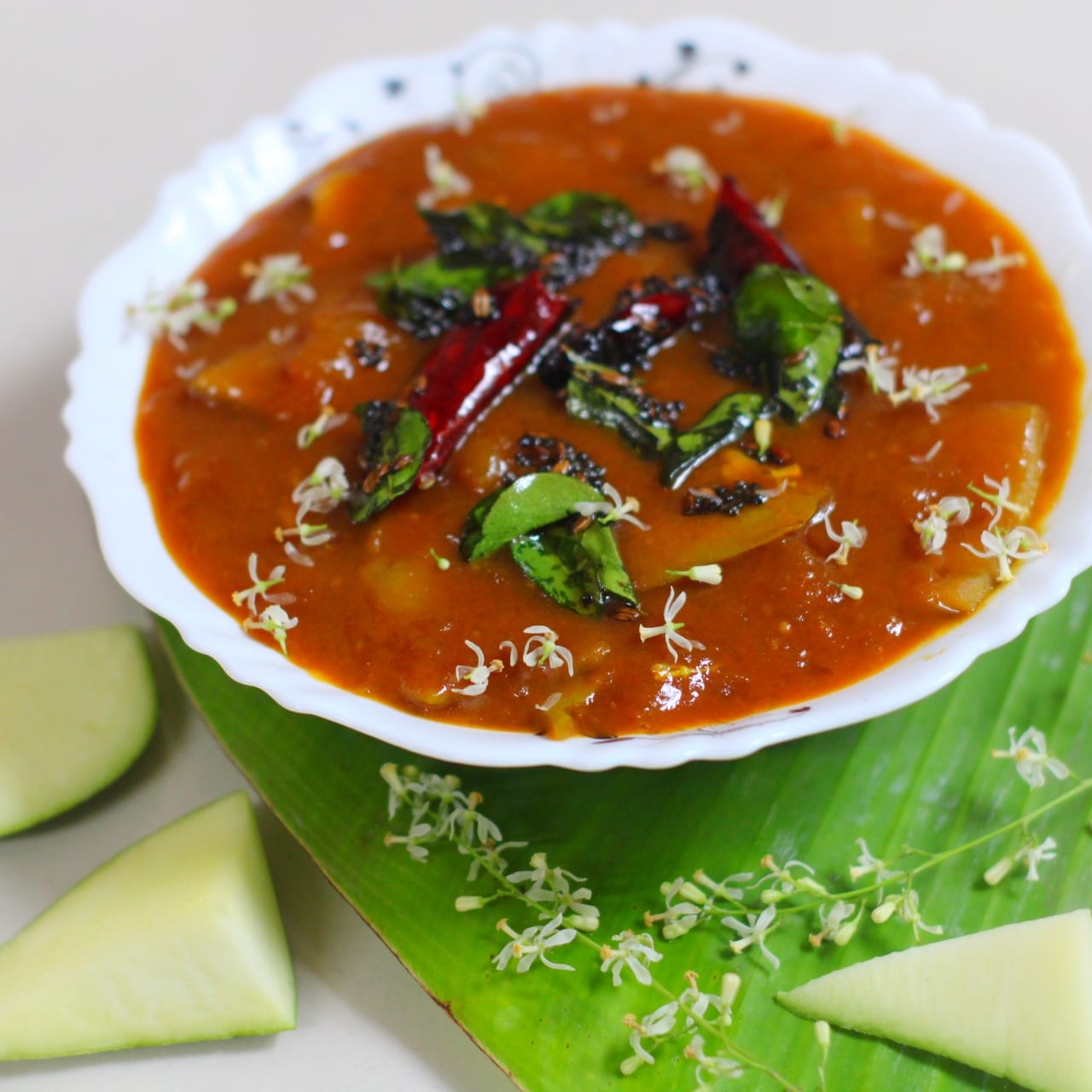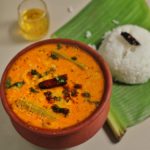An Introduction To Raw Mango Pachadi Recipe:
Devour this dainty delicacy made of raw mango and neem leaves... A wonderful amalgamation of all the six tastes in one dish, this Raw Mango Pachadi is sure to take you on a roller coaster ride...
An Overview On Raw Mango Pachadi:
What is Raw Mango Pachadi?
Raw Mango Pachadi also called as Ugadi Pachadi, is a dainty delicacy from South India, known for its unique taste and alluring aroma. It is an exotic dish that holds within all the six flavors (called as Arusuvai in Tamil) which makes it so special and exclusively delicious.
Why it is prepared for the regional new year?
Food has always been synonymous with festivals in India and we can easily associate certain dishes with specific festivals. All major festivals like Christmas, Diwali, Ramzan, Onam and Dusherra etc., are associated with chosen dishes that go hand in hand with the appropriate festivals. Similarly, Raw Mango Pachadi is one such decadent dessert which has strong connection with the onset of traditional New Year in South India in the states of Tamil Nadu, AndraPradesh, Kerala and Karnataka. All the regional new year falls in between the month of March and April, which is also the season of Mangoes in India. Therefore, the festival includes mango in its celebration and thus the new year and mango becomes inseparable and form a part and parcel of the festival. Moreover, You can find the presence of this inevitable dish Raw Mango Pachadi almost at all households during the season, and you would simply marvel at the variations each region could offer. Every version competes with one another in color, taste and texture and you would be driven with curiosity if you dive deep into the variations and subtleties of each variety.
What makes it so distinctive?
The fusion of all the six tastes in one dish makes it so special and it has also a deep connotation with the philosophy of mixed phases of life. To mark the notion that life is a balance of all ups and downs and one has to embrace it happily, the raw mango pachadi is prepared and offered in the beginning of the New year and this has been in practice since decades in India. This humble mango pachadi holds extraordinary taste and philosophy and no other occasion is perfect to relish this dish other than a new year. Our ancestors have been so thoughtful, responsible and brilliant in incorporating these kind of dishes and blend it with culture and festivals so that it can been carried onto generations with fondness and fervor.
What is the exceptional ingredient added in the raw mango pachadi?
Fresh neem flower is the key ingredient of this Raw Mango Pachadi and it is added on purpose as it has astounding health benefits. Apart from improving the digestive health, neem flowers treat intestinal worms in kids and cures phlegm and a best home remedy for cleansing the system. It is a natural antiseptic that can treat blemishes in the skin and therefore used in cosmetics and aromatherapy. It improves eyesight and aids in treating digestive disorders like excessive bile secretion and also cures itching in the body. Fresh neem flowers soaked in honey is a handy remedy kept at many house holds for treating itchy skin, pimples and to remove toxins from the body. As it improves the metabolic rate of the body, it is helpful in reducing the fat and burns out the calories faster. It is an exceptional antiseptic and aids in the treatment of anorexia, nausea and belching. Our ancestors used to give this to kids on a regular interval to get rid of intestinal worms naturally. Moreover, it has been extensively used in Ayurveda, to treat headaches and skin related issues and to improve eye sight. Studies also prove that the alcoholic extract from neem leaves are being used as an effective contraceptive. Thus, this simple neem flower is power packed with lots of benefits and let us be mindful of the massive therapeutic properties it holds and enjoy the maximum benefit out of it by trying out such phenomenal recipes like the Raw Mango Pachadi.
Here comes the easy recipe of Raw Mango Pachadi that comes with just a few ingredients at home.

Ingredients Required To Make Raw Mango Pachadi Recipe:
How To Make Raw Mango Pachadi Recipe:
Wash the mango well and wipe with a clean cloth.
Chop the mango into large pieces after peeling the skin off.
Boil the chopped mango with a little water, a pinch of turmeric powder along with the required salt and keep aside.
Heat a small pan and drop in the measured quantity of jaggery and add a quarter cup of water to it and keep it in medium flame.
Stir in until it melts down completely, and transfer this jaggery water to a small cup using a tea filter to get rid of impurities if any.
Place the pan again in the stove and tip in a tablespoon of groundnut oil and when it is heated, spill in some mustard seeds to it.
When it pops up, just throw in a little broken urad dal and while it turns golden brown, toss over three or four roughly torn dried red chilies and lower the flame.
Now, sprinkle some curry leaves and let it splutter too.
Add one or two pinches of asafoetida powder and immediately add the neem flowers (after washing and removing the tiny stalks from them) into it with a nice stir.
When it becomes aromatic in a second or two, add the boiled mango chunks into the pan along with the water.
Let the flame continue to remain in medium flame and after two minutes approximately, pour in the jaggery water and stir well.
When it comes to a boil just turn off the stove and now the mango pachadi is ready to eat.
Serve it either hot, chill or at room temperature either as a dessert or as an accompaniment for rice.
Tips And Tricks To Make Raw Mango Pachadi Recipe:
- Any variety of raw mango can be used to make the pachadi and usually the varieties like Totapuri, Hapus, Sindura, Ratnagiri, Raspura, Ottu, Banganapalli, Kili Mooku are used to make the pachadi.
- The mango pachadi usually takes up the color of jaggery we use to make the pachadi and therefore it is advisable to use light colored achu vellam, or katti vellam rather than karuppatti or nattu sarkarai. In some areas, people also use regular white sugar as it gives a crystal clear golden brown color though the traditional version includes only jaggery.
- You can also use sesame oil, coconut oil, ghee or any other cooking oil you use regularly to temper the mango pachadi.
- While peeling off the skin from the mango, do not peel it off completely as a little mango skin here and there gives the needed astringent taste to the Raw Mango pachadi.
- At the final stage, you may add half a teaspoon of rice flour (after diluting it with a little water) to the pachadi and boil for a minute or two and this gives thickness to the pachadi. It is optional as some may like to have it as such with its original consistency.
- At some regions, they may even add a few neem leaves along with the flowers and it tastes equally delicious and too good for health.
- In case, if you do not get fresh neem flowers, you can buy dried neem flowers and it is available at all Indian Stores in the market.
- If you like a little bitter taste and if you also like to have it the more nutritious way, add the fresh neem leaves at the final stage just before you turn off the stove and I personally find this method more tasty and delectable.
- It is also well and good if you can replace asafoetida powder with solid asafoetida for more flavor.
- It can be prepared in bulk during the season and can be stored for months in the refrigerator as both mango and as well as fresh neem leaves are seasonal.
- It is a wonderful dip for variety rice, idli and dosa varieties and a handy accompaniment for any evening tiffin or snack for kids and it is left up to your creativity to use it either as a dessert or as a dip for anything you eat just like ketch up.
Ingredients
Directions
Wash the mango well and wipe with a clean cloth.
Chop the mango into large pieces after peeling the skin off.
Boil the chopped mango with a little water, a pinch of turmeric powder along with the required salt and keep aside.
Heat a small pan and drop in the measured quantity of jaggery and add a quarter cup of water to it and keep it in medium flame.
Stir in until it melts down completely, and transfer this jaggery water to a small cup using a tea filter to get rid of impurities if any.
Place the pan again in the stove and tip in a tablespoon of groundnut oil and when it is heated, spill in some mustard seeds to it.
When it pops up, just throw in a little broken urad dal and while it turns golden brown, toss over three or four roughly torn dried red chilies and lower the flame.
Now, sprinkle some curry leaves and let it splutter too.
Add one or two pinches of asafoetida powder and immediately add the neem flowers (after washing and removing the tiny stalks from them) into it with a nice stir.
When it becomes aromatic in a second or two, add the boiled mango chunks into the pan along with the water.
Let the flame continue to remain in medium flame and after two minutes approximately, pour in the jaggery water and stir well.
When it comes to a boil just turn off the stove and now the mango pachadi is ready to eat.
Serve it either hot, chill or at room temperature either as a dessert or as an accompaniment for rice.



